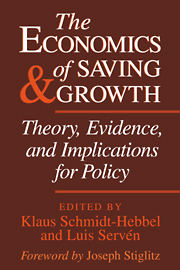3 - Saving and Growth
Published online by Cambridge University Press: 18 December 2009
Summary
Introduction
Few economists would attribute the differences in growth rates between Asia and Africa to the optimal workings of the invisible hand, and most would favor policies that would raise African growth rates. Even in the absence of distortionary policies and even abstracting from skepticism that consumers make adequate intertemporal decisions, most governments and policy makers appear to regard growth as a good thing per se. A necessary (but certainly not sufficient) condition for growth is investment, in machines, in people, or in both. In a closed economy, these investments can come only from postponing consumption, that is from saving. In an international economy, investment in one country can be supported by saving elsewhere in the world, but as a matter of fact, there is a very high correlation between national investment and national saving at least when both are defined to exclude education (for recent assessments, see Feldstein and Horioka, 1980; Feldstein and Bacchetta, 1991; and Bosworth, 1993). Indeed, Feldstein and Bacchetta (1991) conclude that “an increase in national saving has a substantial effect on the level of investment” (p. 218). If so, it is a short step to the conclusion that saving drives growth, and that the appropriate policies for growth are those that promote saving.
That such a conclusion is logically coherent must be checked using a formal growth model, but as we shall see in the next section, the task is readily accomplished.
- Type
- Chapter
- Information
- The Economics of Saving and GrowthTheory, Evidence, and Implications for Policy, pp. 33 - 70Publisher: Cambridge University PressPrint publication year: 1999
- 10
- Cited by



